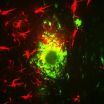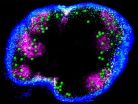(Press-News.org) (SACRAMENTO, Calif.) -- Researchers at UC Davis have illuminated an important distinction between mice and humans: how human livers heal. The difference centers on a protein called PPARα, which activates liver regeneration. Normally, mouse PPARα is far more active and efficient than the human form, allowing mice to quickly regenerate damaged livers. However, the research shows that protein fibroblast growth factor 21 (FGF21) can boost the regenerative effects of human PPARα. The findings suggest that the molecule could offer significant therapeutic benefits for patients who have had a liver transplant or suffer from liver disease. The study was published in the journal Oncotarget.
"We found that FGF21 is a good rescuing molecule that facilitates liver regeneration and perhaps tissue repair," said Yu-Jui Yvonne Wan, vice chair for research in the Department of Pathology and Laboratory Medicine at UC Davis and senior author on the paper. "Our data suggests that FGF21 could help with liver regeneration, either after removal or after damage caused by alcohol or a virus."
In the study, human and mouse PPARα showed different capacities for liver regeneration after surgery. Even after having two-thirds of their livers removed, normal mice regained their original liver mass within seven to 10 days. By contrast, mice with human PPARα never fully regenerated, even after three months. However, by increasing FGF21, the team boosted human PPARα's ability to regenerate and heal mouse livers.
While mouse PPARα has regenerative advantages over the human version, there is also a downside, as this ability can lead to cancer. Human PPARα does not cause cancer; however, as noted, it cannot match the mouse protein's regenerative capacity. This trade-off provides a number of advantages on the human side. For example, several popular drugs target PPARα to treat high cholesterol and triglycerides.
Still, in the right context, a more active human PPARα could be a great boon for patients with liver conditions. Using FGF21 to boost this regenerative capacity is an important step in that direction.
These results also add another line to FGF21's impressive resume. In addition to boosting human PPARα's regenerative impact on the liver, the protein has been shown to alleviate insulin resistance, accelerate fat metabolism, and reduce fatty liver disease in animal models.
"FGF21 is a key molecule to regulate metabolism in the liver," said Wan. "There's research that shows that mice that overexpress FGF21 live 50 percent longer. Now we've shown that it can rescue human PPAR, allowing it to completely regenerate damaged livers in mice. This could provide significant therapeutic benefits for people after transplants or other liver injury."
Other authors included Hui-Xin Liu and Ying Hu at UC Davis, Samuel W. French at Harbor-UCLA Medical Center and Frank J. Gonzalez at the National Cancer Institute.
Researchers at UC Davis have illuminated an important distinction between mice and humans: how human livers heal. The difference centers on a protein called PPARα, which activates liver regeneration. Normally, mouse PPARα is far more active and efficient than the human form, allowing mice to quickly regenerate damaged livers. However, the research shows that protein fibroblast growth factor 21 (FGF21) can boost the regenerative effects of human PPARα. The findings suggest that the molecule could offer significant therapeutic benefits for patients who have had a liver transplant or suffer from liver disease. The study was published in the journal Oncotarget.
"We found that FGF21 is a good rescuing molecule that facilitates liver regeneration and perhaps tissue repair," said Yu-Jui Yvonne Wan, vice chair for research in the Department of Pathology and Laboratory Medicine at UC Davis and senior author on the paper. "Our data suggests that FGF21 could help with liver regeneration, either after removal or after damage caused by alcohol or a virus."
In the study, human and mouse PPARα showed different capacities for liver regeneration after surgery. Even after having two-thirds of their livers removed, normal mice regained their original liver mass within seven to 10 days. By contrast, mice with human PPARα never fully regenerated, even after three months. However, by increasing FGF21, the team boosted human PPARα's ability to regenerate and heal mouse livers.
While mouse PPARα has regenerative advantages over the human version, there is also a downside, as this ability can lead to cancer. Human PPARα does not cause cancer; however, as noted, it cannot match the mouse protein's regenerative capacity. This trade-off provides a number of advantages on the human side. For example, several popular drugs target PPARα to treat high cholesterol and triglycerides.
Still, in the right context, a more active human PPARα could be a great boon for patients with liver conditions. Using FGF21 to boost this regenerative capacity is an important step in that direction.
These results also add another line to FGF21's impressive resume. In addition to boosting human PPARα's regenerative impact on the liver, the protein has been shown to alleviate insulin resistance, accelerate fat metabolism, and reduce fatty liver disease in animal models.
"FGF21 is a key molecule to regulate metabolism in the liver," said Wan. "There's research that shows that mice that overexpress FGF21 live 50 percent longer. Now we've shown that it can rescue human PPAR, allowing it to completely regenerate damaged livers in mice. This could provide significant therapeutic benefits for people after transplants or other liver injury."
INFORMATION:
Other authors included Hui-Xin Liu and Ying Hu at UC Davis, Samuel W. French at Harbor-UCLA Medical Center and Frank J. Gonzalez at the National Cancer Institute.
Learn more at http://cancer.ucdavis.edu
Memory and as well as connections between brain cells were restored in mice with a model of Alzheimer's given an experimental cancer drug, Yale School of Medicine researchers reported in the journal Annals of Neurology.
The drug, AZD05030, developed by Astra Zeneca proved disappointing in treating solid tumors but appears to block damage triggered during the formation of amyloid-beta plaques, a hallmark of Alzheimer's disease. The new study, funded by an innovative National Institutes of Health (NIH) program to test failed drugs on different diseases, has led to the launch ...
Study the label of almost any food product and you're likely to see the rather vague warning "May contain peanuts" somewhere on there, unless of course it's a product that definitely does contain peanuts. As now revealed in a paper in the latest issue of JNIRS--Journal of Near Infrared Spectroscopy, these warnings of peanut contamination could soon lose much of their uncertainty, thanks to a novel form of near infrared (NIR) spectroscopy known as NIR hyperspectral imaging (HSI).
Any food product may contain traces of peanut if it is made with powdered foodstuffs like ...
March 31, 2015 - For chronically ill patients with major depression, an approach to cognitive-behavioral therapy (CBT) that incorporates patients' religious beliefs is at least as effective as conventional CBT, suggests a study in the April issue of The Journal of Nervous and Mental Disease. The journal is published by Wolters Kluwer.
"Integrating religious clients' beliefs into CBT does not appear to significantly reduce its effectiveness, especially in religious clients," write Dr Harold Koenig of Duke University Medical Center, Durham, N.C., and colleagues. They ...
Research by Johns Hopkins scientists suggests that having a short series of phone conversations with trained counselors can substantially boost recovery and reduce pain in patients after spinal surgery.
The phone calls, designed to enrich standard pre- and post-operative care by reinforcing the value of sticking with physical therapy and back-strengthening exercise regimens, are a relatively inexpensive and simple intervention that can maximize surgical outcomes for the hundreds of thousands of Americans who undergo spinal surgeries every year, the investigators say.
A ...
Lung diseases like emphysema and pulmonary fibrosis are common among people with malfunctioning telomeres, the "caps" or ends of chromosomes. Now, researchers from Johns Hopkins say they have discovered what goes wrong and why.
Mary Armanios, M.D., an associate professor of oncology at the Johns Hopkins University School of Medicine., and her colleagues report that some stem cells vital to lung cell oxygenation undergo premature aging -- and stop dividing and proliferating -- when their telomeres are defective. The stem cells are those in the alveoli, the tiny air exchange ...
Increasing state alcohol taxes could prevent thousands of deaths a year from car crashes, say University of Florida Health researchers, who found alcohol-related motor vehicle crashes decreased after taxes on beer, wine and spirits went up in Illinois.
A team of UF Health researchers discovered that fatal alcohol-related car crashes in Illinois declined 26 percent after a 2009 increase in alcohol tax. The decrease was even more marked for young people, at 37 percent.
The reduction was similar for crashes involving alcohol-impaired drivers and extremely drunken drivers, ...
Soil organic matter, long thought to be a semi-permanent storehouse for ancient carbon, may be much more vulnerable to climate change than previously thought.
Plants direct between 40 percent and 60 percent of photosynthetically fixed carbon to their roots and much of this carbon is secreted and then taken up by root-associated soil microorganisms. Elevated carbon dioxide (CO2) concentrations in the atmosphere are projected to increase the quantity and alter the composition of root secretions released into the soil.
In new research in the March 30 edition of the journal, ...
CAMBRIDGE, Mass--Sitting in traffic during rush hour is not just frustrating for drivers; it also adds unnecessary greenhouse gas emissions to the atmosphere.
Now a study by researchers at MIT could lead to better ways of programming a city's stoplights to reduce delays, improve efficiency, and reduce emissions.
The new findings are reported in a pair of papers by assistant professor of civil and environmental engineering Carolina Osorio and alumna Kanchana Nanduri SM '13, published in the journals Transportation Science and Transportation Research: Part B. In these ...
Australian scientists have discovered a new population of 'memory' immune cells, throwing light on what the body does when it sees a microbe for the second time. This insight, and others like it, will enable the development of more targeted and effective vaccines.
Two of the key players in our immune systems are white blood cells known as 'T cells' and 'B cells'. B cells make antibodies, and T cells either help B cells make antibodies, or else kill invading microbes. B cells and killer T cells are known to leave behind 'memory' cells to patrol the body, after they have ...
At some point, probably 50,000 to 100,000 years ago, humans began talking to one another in a uniquely complex form. It is easy to imagine this epochal change as cavemen grunting, or hunter-gatherers mumbling and pointing. But in a new paper, an MIT linguist contends that human language likely developed quite rapidly into a sophisticated system: Instead of mumbles and grunts, people deployed syntax and structures resembling the ones we use today.
"The hierarchical complexity found in present-day language is likely to have been present in human language since its emergence," ...

